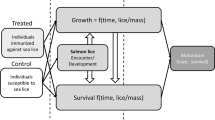Abstract
As free-living sea-lice larvae are difficult to sample directly, lice abundances on fish have recently been used to study larvae in the water. In the KLV problem, juvenile wild salmon migrate past a salmon farm, and the change of infection with distance along the migration route is used to estimate larvae production from the farm. In the farm problem, time-varying infection of sea-cage fish is used to estimate the time-variation of free-living larvae in waters near the farm. Both inverse problems require good forward models for infection. In the farm problem, hosts are relatively large and lice pathogenesis is seldom mortal, whereas in the KLV problem hosts are small and lice-induced host mortality can affect lice abundance; thus, infection models for the farm problem are special cases of models for the KLV problem. Here I give an infection model for the KLV problem that explicitly includes lice clumping and host mortality, showing that Krkosek et al. (Proc R Soc B 272:689–696, 2005) (KLV) probably underestimated larvae production by the salmon farm, and further, that if lice development rates were known from laboratory data, lice abundance field data could be directly inverted for lice-induced host mortality during migration. If lice-induced host mortality is negligible, or if lice are Poisson distributed, infection models of arbitrary complexity reduce to Erlang models. I give two useful Erlang models with their solutions for non-zero initial conditions.
Similar content being viewed by others
References
Anderson D., Watson R.: On the spread of a disease with gamma distributed latent and infectious periods. Biometrika 67(1), 191–198 (1980)
Anderson R.M., May R.M.: Regulation and stability of host-parasite population interactions. I. Regulatory processes. J. Anim. Ecol. 47, 219–247 (1978)
Boxaspen K.: A review of the biology and genetics of sea lice. ICES J. Mar. Sci. 63, 1304–1316 (2006)
Costello M.: Ecology of sea lice parasitic on farmed and wild fish. Trends Parasitol. 22, 475–483 (2006)
Krkosek M., Lewis M.A., Volpe J.P.: Transmission dynamics of parasitic sea lice from farm to wild salmon. Proc. R. Soc. B. 272, 689–696 (2005)
Krkosek M., Lewis M.A., Morton A., Frazer L.N., Volpe J.P.: Epizootics of wild fish induced by farm fish. Proc. Natl. Acad. Sci. USA 103(42), 15506–15510 (2006)
Revie C.W., Robbins C., Gettinby G., Kelly L., Treasurer J.W.: A mathematical model of the growth of sea lice, Lepeophtheirus salmonis, populations on farmed Atlantic salmon, Salmo salar L., in Scotland and its use in the assessment of treatment strategies. J. Fish Dis. 28, 603–613 (2005)
Rousset F., Thomas F., De Meeus T., Renaud F.: Inference of parasite-induced host mortality from distributions of parasite loads. Ecology 77, 2203–2211 (1996)
Shaw D.J., Dobson A.P.: Patterns of macroparasite abundance and aggregation in wildlife populations: a quantitative review. Parasitology 111, S111–S133 (1995)
Shaw D.J., Grenfell B.T., Dobson A.P.: Patterns of macroparasite aggregation in wildlife host populations. Parasitology 117, 597–610 (1998)
Steutel F.W., Van Eenige, M.J.A.: Note on the approximation of distributions on Z+ by mixtures of negative binomial distributions. Commun. Stat. Stochastic Models 13, 271–274 (1997)
Stien A., Bjorn P.A., Heuch P.A., Elston D.A.: Population dynamics of salmon lice, Lepeophtheirus salmonis, on Atlantic salmon and sea trout. Mar. Ecol. Prog. Ser. 290, 263–275 (2005)
Webster S.J., Dill L.M., Butterworth K.: The effect of sea lice infestation on the salinity preference and energetic expenditure of juvenile pink salmon (Oncorhynchus gorbuscha). Can. J. Fish Aquat. Sci. 64, 672–680 (2007)
Author information
Authors and Affiliations
Corresponding author
Rights and permissions
About this article
Cite this article
Frazer, L.N. Sea-lice infection models for fishes. J. Math. Biol. 57, 595–611 (2008). https://doi.org/10.1007/s00285-008-0181-3
Received:
Revised:
Published:
Issue Date:
DOI: https://doi.org/10.1007/s00285-008-0181-3




